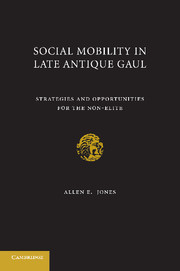Book contents
- Frontmatter
- Contents
- ACKNOWLEDGMENTS
- ABBREVIATIONS
- Gaul in the Late Sixth Century
- CHAPTER ONE INTRODUCTION: BARBARIAN GAUL
- CHAPTER TWO EVIDENCE AND CONTROL
- CHAPTER THREE SOCIAL STRUCTURE I: HIERARCHY, MOBILITY, AND ARISTOCRACIES
- CHAPTER FOUR SOCIAL STRUCTURE II: FREE AND SERVILE RANKS
- CHAPTER FIVE THE PASSIVE POOR: PRISONERS
- CHAPTER SIX THE ACTIVE POOR: PAUPERES AT CHURCH
- CHAPTER SEVEN HEALING AND AUTHORITY I: PHYSICIANS
- CHAPTER EIGHT HEALING AND AUTHORITY II: ENCHANTERS
- CHAPTER NINE CONCLUSION
- BIBLIOGRAPHY
- INDEX
CHAPTER FOUR - SOCIAL STRUCTURE II: FREE AND SERVILE RANKS
Published online by Cambridge University Press: 18 December 2009
- Frontmatter
- Contents
- ACKNOWLEDGMENTS
- ABBREVIATIONS
- Gaul in the Late Sixth Century
- CHAPTER ONE INTRODUCTION: BARBARIAN GAUL
- CHAPTER TWO EVIDENCE AND CONTROL
- CHAPTER THREE SOCIAL STRUCTURE I: HIERARCHY, MOBILITY, AND ARISTOCRACIES
- CHAPTER FOUR SOCIAL STRUCTURE II: FREE AND SERVILE RANKS
- CHAPTER FIVE THE PASSIVE POOR: PRISONERS
- CHAPTER SIX THE ACTIVE POOR: PAUPERES AT CHURCH
- CHAPTER SEVEN HEALING AND AUTHORITY I: PHYSICIANS
- CHAPTER EIGHT HEALING AND AUTHORITY II: ENCHANTERS
- CHAPTER NINE CONCLUSION
- BIBLIOGRAPHY
- INDEX
Summary
…the father said, “Why, dearest son, do you refuse my paternal will and wish not to marry, so that you can cause your seed to be a benefit for our family for ages to come? For our labor is all for naught, if there will be none to enjoy its fruits.”
GREGORY OF TOURS, De Vita Patrum 20.1This chapter will continue laying out a model for society in Barbarian Gaul. The previous chapter focused on participants within Gaul's multiple aristocracies, large landowners, prominent courtiers, and ecclesiastical aristocrats. Gallic authors characterized people who succeeded in their strategies of marrying with landed elites, acquiring high secular office and prominently patronizing churches as society's “best” (optimi). But, as the hopeful expression of a non-aristocratic father for his son to continue the family line, presented in this chapter's introductory quote, indicates, schemes for social improvement in fact might differ between nobles and non-elites only by a matter of degrees. This chapter concentrates on details of people from the lower social ranks as they sought social betterment through marriage, pursuit of secular office, and church affiliation. Analysis will progress according to descending rank, free to slave. Freepersons will be divided into two groups, ingenui and pauperes, according to terminology used by contemporary writers. But even this division cannot do justice to the variation, economic and otherwise, that existed within the large “middling” group of people that archaeologists and social historians are now realizing characterized late ancient societies.
- Type
- Chapter
- Information
- Social Mobility in Late Antique GaulStrategies and Opportunities for the Non-Elite, pp. 129 - 179Publisher: Cambridge University PressPrint publication year: 2009



